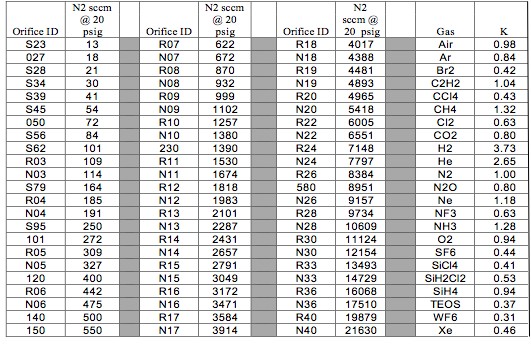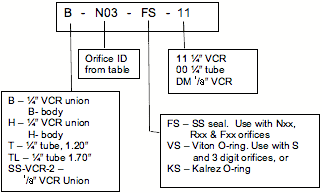QN2 = (Q/K) x (34.70/Pi) Po < Pi /2
Also, multiply Q by (293/Tgas)1/2with T in Kelvins, if the temperature of the application gas differs significantly from 20oC.
Now, if Po > Pi /2 substitute 17.35/[Po(Pi -Po)]1/2 for (34.70/Pi).
The N and R orifices are synthetic sapphire. The S and 3 digit orifices are silicon. Stainless steel orifices use the ID
code FXX where XX us the diameter rounded off in thousands of an inch. Use:
XX = SQRT[2.59Q/(KPi)]
SS orifices are available from .030" (FXX=F30) to 0.0.80". We also stock .005" SS orifices (F05)
Po = Pi /2[1 + (1 - f2)1/2]
Then assure that Po (restrictor outlet, & MFC inlet) is sufficient to provide the needed dP for the MFC.
For example with Qmax=2Q, P o=0.933Pi
|
With an MFC downstream from the restrictor, both Pi and Q are known, but Po is unknown. At Pi the restrictor flow Qmax, is some multiple of Q. If f = Q/Qmax, then |
Then assure that Po (restrictor outlet, & MFC inlet) is sufficient to provide the needed dP for the MFC.
For example with Qmax=2Q, P o=0.933Pi
|
|
Table: Stock orifice ID from N2 flow @ 20 psig
 |
The orifices are listed by increasing size with a separation designed such that no matter what flow specification there is an orifice within a few percent of the requirement. Any orifice can be embeddded in any of our bodies of tubes, filters, or VCR unions  |
|
B series 1/4" VCR M/M 1.55" length 1/4" VCR M/F or F/M 1.80" length See Detailed Information |
Tube 1/4" SS tube. See Detailed Information |
H series 1/4" VCR M/M 1.55" length. See detailed information |